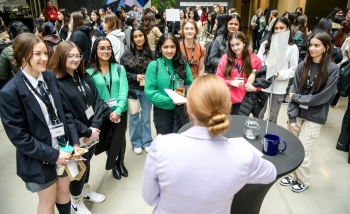It is difficult to pick out which field of science has been most impacted by the theorems Emmy Noether formulated more than a century ago.
“In every field of science, they’re now absolutely fundamental,” says Yvette Kosmann-Schwarzbach, a mathematics professor at École Polytechnique in Paris. And yet, despite their broad applicability today and their initial recognition from other great contemporaries such as Hilbert, Klein, and Einstein, Noether’s theorems languished in obscurity for nearly 50 years after their publication in 1918.
Kosmann-Schwarzbach is helping to remedy that through her book The Noether Theorems: Invariance and Conservation Laws in the Twentieth Century, which delves not only into the mathematical and physical repercussions of Noether’s work, but into its historical context as well. She presented an overview of her findings at a colloquium at Perimeter in December 2018.
As a mathematician, Kosmann-Schwarzbach’s interest in Noether was first piqued in the late 1980s. While writing a short paper on Noether’s work, she learned that Noether had discovered not just one but two revolutionary theorems. Later, one of her students at École Polytechnique asked for an essay topic. She suggested he translate the article from Noether’s native German to Kosmann-Schwarzbach’s native French. Armed with a thorough translation, she could fully immerse herself in Noether’s work.
Noether’s results, she found, were brilliant and broadly applicable. In the simplest terms, she explains, Noether showed that any system with a symmetry[1] (and symmetries are rather ubiquitous in the natural world) also comes with an associated conserved quantity.
Why, then, did they fly under the radar for so long? “It’s a good question, and I think we don’t know,” replies Kosmann-Schwarzbach. “We find traces of propagation through the Soviet Union, which is kind of surprising, but we don’t know why her work was ignored for such a long time.” Perhaps, she muses, scientists in Western Europe and America didn’t care to read an article written in German. Some may have been averse to citing a woman or a Jewish person.
But a lack of recognition does not equate to a lack of importance. “What is interesting is that her work was actually rediscovered many times,” she says. “So it means the ideas and results are fundamental, they’re natural, they’re useful.”
Kosmann-Schwarzbach is hesitant to pin the temporary disappearance of the theorems on the fact that Noether was a woman. Certainly, she says, Noether’s life would have been different if she had been a man – for one thing, she would have faced fewer obstacles in obtaining paid positions. But she points out that Noether’s later work, in algebra, became quite widely known and celebrated.
“She gave a talk in the International Congress of Mathematicians [in 1932] – she was a plenary speaker – so I think she was not discriminated against as a woman in her work, in the impact of her work.”
Today, Kosmann-Schwarzbach says women scientists face much less discrimination and have far more opportunities. But there is always room for improvement: “There is a large potential of people who are not actually scientists, but who could be, and many of them are women.”
Watch Kosmann-Schwarzbach’s colloquium at Perimeter, “Emmy Noether’s two theorems, a hundred years later."
[1] A feature of a system that remains unchanged under a transformation. Kosmann-Schwarzbach gives the example of rotating a tree about its axis (its trunk): a symmetrical tree would look the same as you spin it around.
Further exploration
- In perspective: Read about Sonali Mohapatra's experience learning of Emmy Noether as a young woman scientist
- In profile: Emmy Noether and the poetry of logical ideas
- Fun stuff: Noether's theorem explained, from kindergarten to PhD
- Watch the talk: Yvette Kosmann-Schwarzbach's colloquium "Emmy Noether's two theorems, a hundred years later"
About PI
Perimeter Institute is the world’s largest research hub devoted to theoretical physics. The independent Institute was founded in 1999 to foster breakthroughs in the fundamental understanding of our universe, from the smallest particles to the entire cosmos. Research at Perimeter is motivated by the understanding that fundamental science advances human knowledge and catalyzes innovation, and that today’s theoretical physics is tomorrow’s technology. Located in the Region of Waterloo, the not-for-profit Institute is a unique public-private endeavour, including the Governments of Ontario and Canada, that enables cutting-edge research, trains the next generation of scientific pioneers, and shares the power of physics through award-winning educational outreach and public engagement.
You might be interested in



